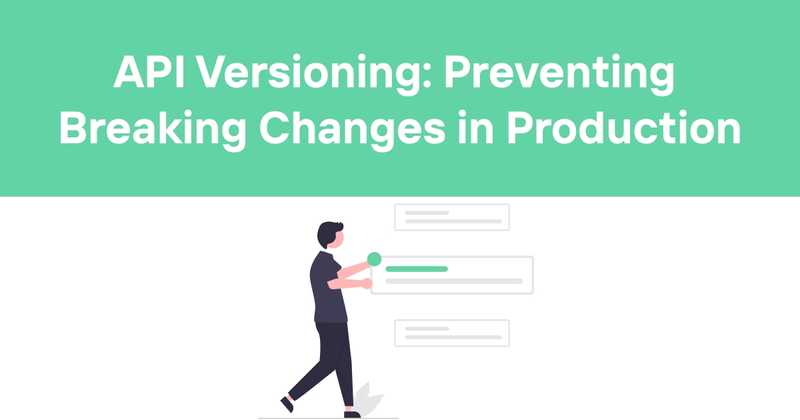API Versioning: Preventing Breaking Changes in Production
API versioning is a critical element of API design that often gets overlooked until it's too late. I've seen too many developers rush into building their APIs without thinking about how they'll handle inevitable changes down the road. This leads to frustrated consumers, broken applications, and technical debt that's difficult to manage.
When done correctly, API versioning allows teams to make necessary changes to their APIs without destroying the experience for existing users. Let's dive into the world of API versioning to understand what it is, why it matters, and how to implement it effectively.
Table of contents
What is API versioning?
API versioning is the process of managing and tracking changes to an API throughout its lifecycle. It provides a systematic way to introduce updates, new features, and breaking changes while maintaining backward compatibility for existing consumers.
Think of API versioning as similar to product versioning in software development. When you release a new version of your software, you typically assign it a version number (like 2.0) to indicate significant changes. API versioning works the same way, allowing developers to clearly communicate the state of their API to consumers.
The goal of versioning is to ensure that changes to your API don't unexpectedly break applications that depend on it. This is especially important for public APIs, where you often don't have direct control over when consumers update their integration code.
Why API versioning matters
APIs need to evolve over time. Business requirements change, security vulnerabilities need patching, and developers frequently discover better ways to structure data or handle requests. But any change to an API potentially affects all applications that use it.
Without proper versioning, even minor API changes can cause major problems. For example:
- A consumer's application might start receiving data in an unexpected format, causing parsing errors
- Required fields might be missing from requests, resulting in validation failures
- Applications might try to access endpoints that no longer exist
The real business impact is significant. When an API changes without warning, it can lead to:
- Downtime for consumer applications
- Lost revenue for both API providers and consumers
- Frustrated developers and damaged relationships
- Increased support burden dealing with confused consumers
- Damaged reputation that impacts API adoption rates
Good API versioning builds trust with consumers by providing a predictable experience. It allows API providers to innovate and improve their APIs without fear of breaking downstream applications.
When to version your API
Not every change to an API requires a new version. You should typically create a new API version when you make "breaking changes" - modifications that would require consumers to update their code to continue working properly.
Common examples of breaking changes include:
-
Removing or renaming fields: If you remove a field that consumers might rely on, or rename an existing field, consumer applications will break when they try to access nonexistent data.
-
Changing data types: If you change a field from a string to an integer, or from a single value to an array, consumer applications may fail when trying to process the unexpected data type.
-
Changing response formats: Significant restructuring of how your data is organized in responses can break consumer parsing logic.
-
Modifying URL structures: Changing endpoint paths forces consumers to update their request URLs.
-
Adding required request parameters: If you make a previously optional parameter mandatory, existing consumers will fail validation checks.
-
Changing authentication mechanisms: Moving from API keys to OAuth, for example, requires consumers to completely rework their authentication approach.
-
Modifying error responses: Changing error codes or formats can break consumer error handling logic.
Here's a simple guideline: if a change would require consumers to modify their code to maintain the same functionality, it's a breaking change that warrants a new version.
Non-breaking changes, on the other hand, typically don't require a new version. These include:
- Adding new optional fields to responses
- Adding new endpoints that don't replace existing ones
- Extending enumerations with new values (with proper defaults)
- Bug fixes that restore intended behavior
- Performance improvements that don't change functionality
Common API versioning strategies
There are several approaches to implementing API versioning, each with their own advantages and disadvantages. Let's look at the most common strategies:
URI path versioning
With URI path versioning, the version number is included directly in the URL path:
https://api.example.com/ v2/products
Pros:
- Very explicit and visible
- Easy for consumers to understand and implement
- Works with all HTTP clients without special configuration
- Simplifies caching since different versions have distinct URLs
Cons:
- Violates REST principles (resources should have a single URI)
- Can create duplication in API documentation
- May require more complex routing logic on the server
Many major companies use URI versioning, including Twitter, Facebook, and Stripe. It's arguably the most common approach for public APIs due to its simplicity and visibility.
Query parameter versioning
This approach adds the version as a query parameter:
https://api.example.com/ products?version=2
Pros:
- Keeps the resource URI consistent
- Easy to implement on both server and client
- Doesn't require special headers
Cons:
- More easily overlooked by developers
- Can interfere with other query parameters
- May cause caching issues if not handled properly
This approach is less common for public APIs but can work well for internal APIs where documentation and developer experience are less critical.
Header versioning
With header versioning, the version information is included in a custom HTTP header:
Host: api.example.com
Accept-version: 1.0
Pros:
- Keeps URLs clean and consistent
- Adheres better to RESTful principles
- Separates versioning concerns from the resource identification
Cons:
- Less visible and intuitive
- Requires more sophisticated API clients
- Harder to test directly in a browser
- More complex for consumers to implement
GitHub's API uses a custom header approach with the Accept header, showing that it can work well for developer-focused APIs.
Content negotiation versioning
This approach uses HTTP content negotiation mechanisms, typically with the Accept header:
Host: api.example.com
Accept: application/vnd. example.v1+json
Pros:
- Follows HTTP standards for content negotiation
- Allows versioning at the representation level rather than the resource level
- Can version individual resources rather than the entire API
Cons:
- More complex to implement
- Less intuitive for many developers
- Requires more sophisticated API clients
- Difficult to test without specialized tools
This approach is favored in environments that prioritize RESTful purity but requires more sophisticated consumers.
Consumer-based versioning
With consumer-based versioning, the server tracks which version each consumer is using:
- When a consumer first uses the API, the server records which version exists at that time
- All future requests from that consumer use that version by default
- Consumers can explicitly opt into newer versions when ready
Pros:
- Minimizes immediate breaking changes for consumers
- Allows gradual migration at the consumer's pace
- Can reduce the need for consumers to change their code
Cons:
- Much more complex to implement on the server
- Requires tracking consumer state
- Can lead to maintaining many versions simultaneously
This approach is less common but can work well for APIs with a stable, known consumer base.
Versioning schemes
Once you've chosen a versioning strategy (how to communicate the version), you also need to decide on a versioning scheme (how to number your versions).
Semantic versioning
Semantic versioning (SemVer) follows a three-part number format: MAJOR.MINOR.PATCH (e.g., 2.1.3)
- MAJOR: Incremented for breaking changes
- MINOR: Incremented for new features that are backward compatible
- PATCH: Incremented for backward-compatible bug fixes
For APIs, you typically expose only the major version to consumers (v1, v2), while tracking minor and patch versions internally.
SemVer is widely used in software development and provides a clear signal about the nature of changes in each release.
Date-based versioning
Date-based versioning uses a date as the version identifier, typically in a YYYY-MM-DD format:
This approach works well when:
- Your API has a predictable release schedule
- You want to clearly communicate when changes were made
- You maintain versions for extended periods
Azure and AWS often use date-based versioning for their APIs.
Implementing API versioning: step-by-step
Implementing API versioning requires careful planning and execution. Here's a step-by-step approach:
-
Choose your versioning strategy early
Make versioning decisions during the API design phase, not after problems arise. Consider your team's capabilities, consumer base, and long-term maintenance plans.
-
Establish a versioning policy
Document when and why you'll create new versions. Define what constitutes a breaking change and how long you'll support older versions.
-
Implement the technical infrastructure
Set up routing, controllers, and services to handle multiple API versions simultaneously. This might include:
- Version-specific route handling
- Controller inheritance or composition
- Service layer abstractions to handle version differences
- Conversion utilities between data formats
-
Create comprehensive documentation
For each version, provide detailed documentation that includes:
- Available endpoints and their functionality
- Request and response formats
- Authentication requirements
- Examples and use cases
- Migration guides for moving between versions
-
Test thoroughly
Implement automated tests that verify each version functions correctly. Include tests that specifically check for version-specific behavior.
-
Deploy and monitor
Roll out new versions gradually, monitoring for issues. Track usage metrics for each version to inform deprecation decisions.
-
Communicate with consumers
Proactively notify consumers about:
- New versions and their features
- Deprecation timelines for older versions
- Migration guides and support options
-
Plan for deprecation
Establish a clear timeline and process for retiring old versions. Provide ample notice and migration support.
API versioning best practices
Based on industry experience and best practices, here are key recommendations for effective API versioning:
Design with extensibility in mind
Think about future changes during initial API design. Choose data structures that can easily accommodate additions without breaking changes:
- Use objects rather than primitive types for fields that might need to expand
- Consider collections that can grow by adding elements
- Avoid boolean fields that can't evolve (use enums instead)
- Design for optional fields rather than required ones where possible
Maintain backward compatibility whenever possible
Strive to avoid breaking changes. Often, you can add new functionality without breaking existing consumers:
- Add new endpoints instead of changing existing ones
- Add new optional fields rather than modifying existing ones
- Support both old and new patterns temporarily during migration
Document changes comprehensively
Maintain detailed changelogs and version-specific documentation. For each version change, document:
- What changed and why
- Potential impact on consumers
- Migration steps for affected consumers
- Examples showing both old and new usage patterns
Implement a clear deprecation policy
Establish and communicate a consistent approach to retiring old versions:
- Announce deprecation schedules well in advance (6-12 months is common)
- Provide tools and guidance for migrating to newer versions
- Consider adding deprecation warnings in responses
- Monitor usage of deprecated versions to inform timing
Test across versions
Implement testing strategies that verify all supported versions work correctly:
- Maintain test suites for each active version
- Test upgrade paths to ensure smooth migrations
- Include version-specific edge cases in your tests
Decouple implementation from interface versioning
Your implementation can change without requiring API version changes as long as the contract remains stable. Separate:
- API contract versioning (what consumers see)
- Implementation versioning (your internal code)
This allows you to improve your implementation without forcing consumers to upgrade.
Common API versioning mistakes to avoid
Even experienced teams can make mistakes with API versioning. Here are common pitfalls to avoid:
Not versioning from the start
Many teams begin without versioning, thinking they'll add it later when needed. By the time breaking changes are necessary, it's much harder to retrofit versioning.
Changing the versioning strategy midway
Switching from URL versioning to header versioning, for example, is itself a breaking change. Pick a strategy and stick with it.
Creating new versions too frequently
Each version increases maintenance burden. Only create new versions for significant breaking changes, not for every minor update.
Poor communication with consumers
Failing to clearly communicate version changes and deprecation plans leads to frustrated consumers and support headaches.
Inconsistent versioning across APIs
If your organization provides multiple APIs, use consistent versioning approaches across all of them. Inconsistency creates confusion and increases integration complexity.
Ignoring the "invisible API contract"
Consumers often rely on undocumented behavior or data structures. Consider Hyrum's Law: "With a sufficient number of users of an API, it does not matter what you promise in the contract: all observable behaviors of your system will be depended on by somebody."
Abandoning old versions too quickly
Forcing consumers to migrate too frequently creates resentment and may drive them to competitor APIs. Balance innovation with stability.
Tools and libraries for API versioning
Several tools and frameworks can help implement API versioning:
-
OpenAPI (Swagger) - Provides tools for defining and documenting versioned APIs
-
API Gateways - Tools like Kong, Amazon API Gateway, and Apigee support various versioning strategies and can handle routing requests to the appropriate API version
-
Framework-specific tools:
- Spring Boot - Offers versioning support through annotations and request mapping
- ASP.NET Core - Provides ApiVersion attributes and versioning middleware
- Express.js - Has various middleware packages for API versioning
-
Version management platforms - Solutions like Postman, SwaggerHub, and Readme.io help manage and document multiple API versions
-
API monitoring tools - Services like Odown can help track usage across different API versions, ensuring reliability and identifying when versions can be deprecated safely
Monitoring your API versions
Effective monitoring is crucial for managing API versions. You need visibility into:
-
Usage by version - Which versions are actively used and by how many consumers
-
Performance by version - Are older versions performing differently than newer ones?
-
Error rates by version - Are certain versions experiencing more issues?
-
Consumer migration patterns - How quickly are consumers adopting new versions?
This data informs decisions about:
- When to deprecate old versions
- Whether migration support is adequate
- If performance optimizations are needed for specific versions
API monitoring tools like Odown provide these insights through:
- Uptime monitoring across API versions
- Performance tracking by endpoint and version
- Usage analytics to inform version lifecycle decisions
- Alert systems that can notify you of version-specific issues
Odown's API monitoring capabilities can help you maintain high availability across all your API versions, ensuring consumers have a reliable experience regardless of which version they're using. The platform also offers public status pages that can communicate version-specific incidents or maintenance to your API consumers.
Additionally, Odown's SSL certificate monitoring ensures that security remains strong across all API versions, alerting you before certificates expire and potentially disrupt your API service.
Final thoughts
API versioning isn't just a technical necessity—it's a commitment to your consumers. A thoughtful versioning strategy demonstrates respect for the developers building on your platform and helps build long-term trust.
The effort invested in proper API versioning pays dividends through:
- Higher consumer satisfaction and retention
- Reduced support burden
- Ability to innovate without breaking existing integrations
- Clearer communication between API producers and consumers
By following the strategies and best practices outlined in this article, you can create a versioning approach that balances innovation with stability. Start with a clear strategy, communicate effectively with consumers, monitor usage across versions, and plan for the entire API lifecycle.
With tools like Odown for monitoring API performance and availability across versions, you can ensure that all consumers have a reliable experience, regardless of which version they're using. Proper monitoring also helps inform version deprecation decisions based on actual usage data rather than arbitrary timelines.
Remember that API versioning isn't just about technology—it's about maintaining relationships with the developers who depend on your API. Treat those relationships with care, and your API will thrive.



